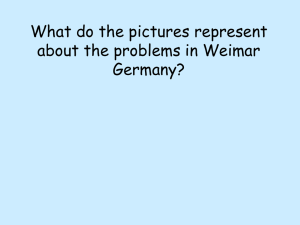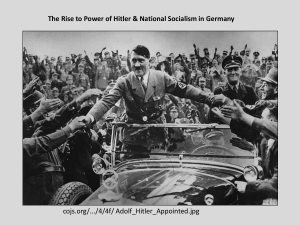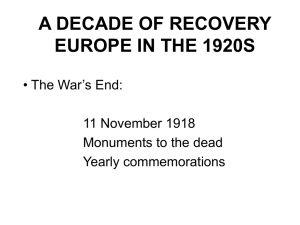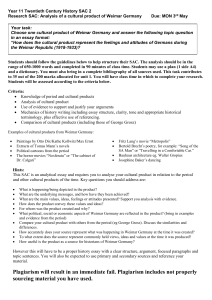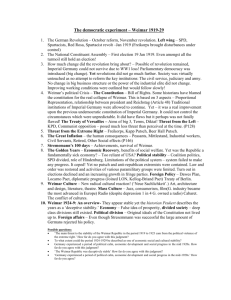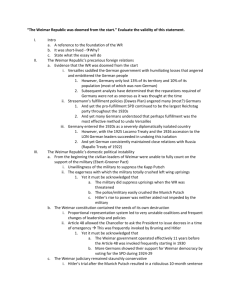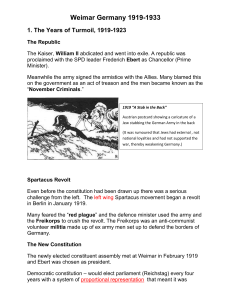Weimar Germany (1918
advertisement
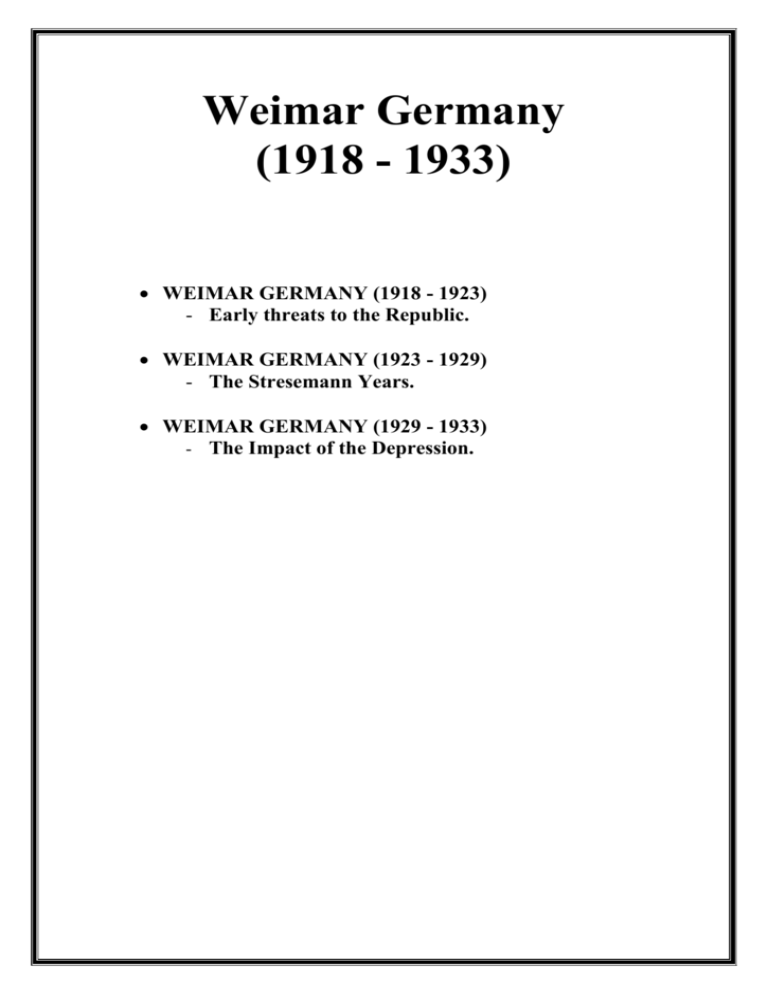
Weimar Germany (1918 - 1933) WEIMAR GERMANY (1918 - 1923) - Early threats to the Republic. WEIMAR GERMANY (1923 - 1929) - The Stresemann Years. WEIMAR GERMANY (1929 - 1933) - The Impact of the Depression. GCSE Revision Notes Weimar Germany (1918 - 1933) WEIMAR GERMANY (1918 - 1923) Early threats to the Republic The Creation of the Weimar Republic: On 9 November 1918 the Kaiser abdicated and fled to Holland. On 11 November 1918 Germany signed an armistice ending WW1. Friedrich Ebert, leader of the Social Democratic Party, declares Germany a republic. On 5 January 1919 The Spartacist Uprising erupts and is defeated by the army. On 19 January 1919 Ebert is elected President of the German Republic. The new democratic government meets in the town of Weimar because Berlin is too dangerous. The Problems of the Weimar Republic (1918 - 1923) included: It had to accept the terms of the Treaty of Versailles. The Weaknesses of its Constitution. Leftwing Revolts like the Spartacist Uprising, Berlin and Bavaria Revolts. Rightwing Revolts like the Kapp Putsch and Munich Putsch. The French Occupation of the Ruhr. Hyperinflation. The Treaty of Versailles. The terms of the Treaty of Versailles included: Germany had to accept War Guilt (sole responsibility for starting the war). Germany had to pay £6600 million in reparations (fines for the war damage). Germany had to give up large amounts of its territory. Germany had to agree to the disarmament of its armed forces. Germany was forbidden from uniting with Austria. Germany had to give up all of its overseas colonies. German reaction to the Treaty of Versailles included: They were enraged when they saw the extremely harsh terms of the treaty. They were not allowed to negotiate over its terms and were forced to accept it. They felt that the terms of the treaty were extremely unfair and humiliating. They felt that they should not have to accept sole responsibility for the war. Many Germans started calling for revenge to reverse the effects of the treaty. Many Germans attacked the new Weimar democratic government for signing it. Many labelled the politicians who signed the treaty “November Criminals” who had “stabbed in the back” the army, which still controlled most of Europe in 1918. H. Alnassiri 2 GCSE Revision Notes Weimar Germany (1918 - 1933) The treaty undermined the new democratic government, led to the rise of the Nazi party and the Second World War. Leftwing attacks against the Weimar Republic The Causes of the Spartacist Uprising (1919) were: The Spartacist League led by Rosa Luxemburg and Karl Liebknecht wanted a Communist Revolution in Germany inspired by the Communist Revolution in Russia. The Spartacist League renamed itself the German Communist Party. On 5 January 1919 the Spartacists seized government buildings and organised a general strike. The Consequences of the Spartacist Uprising (1919) were: The army quickly crushed the Spartacist Uprising and its leaders were shot. Ebert did a deal with the army whereby in return for crushing the Spartacist Uprising he promised not to create a new army sympathetic to the new Weimar Republic. The Berlin and Bavaria Communist Revolts (1919): The new Weimar government faced further uprisings by Communists. In March 1919 the Communists organised strikes in Berlin but were crushed by the Freikorps (Free Corps). In April 1919 the German province of Bavaria declared itself an independent Communist Republic but again was crushed by the Freikorps. Rightwing attacks against the Weimar Republic The Kapp Putsch (1920): The Treaty of Versailles had restricted Germany’s army to 100,000 men and many of the demobilised soldiers joined the Freikorps (Free Corps). The Allies demanded that the Ebert disband the Freikorps. Wolfgang Kapp, leader of Freikorps, marched into Berlin to seize power. Ebert called upon the workers of Berlin to support the Weimar government. The workers organised general strikes and the Kapp Putsch failed. H. Alnassiri 3 GCSE Revision Notes Weimar Germany (1918 - 1933) The Munich Putsch (1923): Hitler and the Nazi party tried to seize power in the city of Munich, capital of the German province of Bavaria to spark the overthrow of the Weimar government. As the Nazis marched in the city centre armed police and army soldiers who fired upon them in support of the Weimar government. Hitler and the other Nazis leaders were arrested and imprisoned. Hitler used his trial to gain maximum publicity to portray himself as a national hero. He used his time in prison to right his book “Mein Kampf” that outlined his ideas. He decided to seize power “legally” by fighting and winning elections rather than by trying another Putsch Economic Problems of the Weimar Republic The Occupation of the Ruhr (1923): The Treaty of Versailles ordered Germany to pay £6600 million in reparations. In 1922 the German government announced it could not pay reparations any longer. The French invaded the Ruhr industrial region to get reparations by force. The French took control of the Ruhr’s factories, steelworks, mines and railways. The Weimar Government could not defend itself because Versailles had limited the size of the German armed forces. The French shot 132 Germans and expelled 150,000 Germans from the region for refusing to obey the orders of the French military controlling the Ruhr. As a result of the occupation of the Ruhr and the resistance against it industrial production in Germany ground to a halt. Hyperinflation (1923): To pay for reparations the German started printing money but this caused hyperinflation because the more money it printed the more worthless it became. As a result of hyperinflation prices would rise, which led to the demand for wages to rise, which led more money being printed, which led to prices to rise more. The price of goods always tended to rise faster than workers wages. Workers were seen carrying their wages home in wheelbarrows. The rise in prices meant that incomes were too small to live on. People struggled to buy food, clothes and to heat their homes. People with savings in banks now found that their savings were worthless. People on fixed incomes like pensioners suffered the most. Only people who had debts or had taken out loans benefited from hyperinflation. H. Alnassiri 4 GCSE Revision Notes Weimar Germany (1918 - 1933) Hyperinflation increased the unpopularity of the Weimar government. The Weimar Constitution The Weimar Constitution: The Weimar Constitution made Germany a democracy. The President was to be elected by the people every 7 years. The Chancellor (Prime Minister) had to have the support of a majority of the Reichstag (Parliament). All man and women over 20 years old could vote for members of the Reichstag. The voting system was based on Proportional Representation whereby if a party won 5% of the vote it would get 5% of the seats in the Reichstag. It made Germany a Federal Republic where each state had its own government. It guaranteed personal freedoms like freedom of speech and freedom of religion. The Weaknesses of the Weimar Constitution: The President had the power to appoint and dismiss the Chancellor. The President, under Article 48 of the Constitution, could suspend democracy. Proportional Representation meant that no party ever had an overall majority in the Reichstag and this lead to a series of weak coalition governments. Proportional Representation gave a voice in the Reichstag to small extremist parties like the Nazi Party. H. Alnassiri 5 GCSE Revision Notes Weimar Germany (1918 - 1933) WEIMAR GERMANY (1923 - 1929) The Stresemann Years The role of Stresemann includes: Between 1923 and 1929 the Weimar Republic became stable and prospered. Gustav Stresemann, leader of the German People’s Party (DVP) became Chancellor in 1923 and was Germany’s Foreign Minister between 1923 to 1929. He brought about economic recovery in Germany. He brought improved international relations for Germany. Economic recovery (1923 - 1929): Stresemann introduced a new currency, the Rentenmark, to replace the old worthless currency to help stop hyperinflation. He ordered striking workers in the Ruhr to go back to work and agreed to start repaying reparations to the allies leading to the French withdrawal in 1925. . 1924 Germany agreed to the Dawes Plan with the US, Britain and France. The USA lent Germany 800 gold million marks to build new factories to increase German prosperity to raise the standard of living and ability to pay back reparations. The Dawes Plan spread the load of reparations according to Germany’s ability to pay based on the prosperity of the German economy. The Dawes Plan restored confidence in the German economy and investments poured into Germany from abroad. The Young Plan of 1929 extended the deadline for the payment of German reparations further 59 years. The USA lends Germany money. The Allies pay back war debts to the USA. THE DAWES PLAN The Germany economy prospers. Germany pays reparations to the Allies. H. Alnassiri 6 GCSE Revision Notes Weimar Germany (1918 - 1933) Germany’s International Relations (1923 - 1929): The international community accepted Germany back on the world stage. In 1925 French troops ended their occupation of the Ruhr. In 1925 Germany and France sign the Locarno Pact in which they agreed never to change the border between them again. In 1926 Germany was allowed to join the League of Nations. In 1928 Germany signed the Kellogg-Briand Pact with over 60 countries promising never to go to war against one another. The successes of the Stresemann Era were: The Weimar Republic was its most stable and prosperous between 1923 to 1929. There was a fall in the support for leftwing and rightwing extremists. The German economy stabilised and hyperinflation was brought under control. Germany was welcomed back on to the world stage. Germany experienced a huge cultural revival. The Failures of the Stresemann Era were: Germany was now dependent on US loans that would prove disastrous in 1929. The weaknesses of the Weimar constitution remained. There continued to be resentment against the Treaty of Versailles. Rightwing movements attacked decadent and unpatriotic new culture that spread across Germany. Finally the stability and prosperity of the Stresemann Era collapsed following the 1929 Wall Street Crash and start of the Depression. WEIMAR GERMANY (1929 - 1933) The Impact of the Depression The impact of the Depression on Germany 1929 – 1933 was: The US demanded its loans back but Germany could not pay. By 1932 over six million Germans were unemployed. Millions became homeless and dependent on charity to survive. There was a growth in support for both leftwing and rightwing extremist parties like the Communist and Nazi Party. The Weimar Republic became extremely unpopular and seemed incapable of pulling Germany out of the Depression. Hitler and Nazi Party did not change their political message but more people were willing to listen to their message now that times were bad. In 1933 Hitler seized power in Germany bringing an end to the Weimar Republic. H. Alnassiri 7 GCSE Revision Notes Weimar Germany (1918 - 1933) GLOSSARY Abdicate (To give up political power.) Armistice (ceasefire.) Chancellor (The German Prime Minister.) Communism (Belief in creating an equal society by workers organising a revolution against the ruling class.) Democracy (Countries whose governments are chosen by free and fair elections.) Depression (The rapid loss of wealth in the economy.) Disarmament (Getting rid of countries weapons.) Economy (The wealth of a country or how businesses in a country are doing.) Freikorps (The Free Corps were extreme rightwing soldiers who kept there weapons after being demobilised at the end of WW1 to fight Communism.) Kaiser (The title of the German King.) League of Nations (The organisation set up after WW1 to keep world peace.) Leftwing (Parties that want to change things to create a more equal society e.g. socialists, communists etc.) Nazi Party (Short for the German abbreviation NSDAP which stands for the National Socialist German Workers Party.) November Criminals (The nickname of the German politicians who agreed to an armistice in 1918 and later signed the Treaty of Versailles.) Putsch (German for coup meaning an attempt to seize power by force.) Reichstag (The German Parliament.) Reparations (Financial fines for the war damage.) Republic (A country without a monarchy.) Rightwing (Parties that want things to stay the same or get even stricter e.g. nationalists, fascists, Nazis etc.) Stabbed-in-the-Back Theory (The belief amongst German soldiers that they were undefeated during the war but had been betrayed by politicians, communists and Jews into surrendering at a time when they still occupied large parts of Europe.) Strikes (When workers refuse to work in protest against something.) Treaty of Versailles (The treaty forced on Germany after WW1.) War Guilt (Accepting sole responsibility for starting the war.) H. Alnassiri 8 GCSE Revision Notes Weimar Germany (1918 - 1933) Weimar Germany (1918 - 1933). No Unsure Yes? Weimar Germany 1918 – 1923 (Early Threats to the Republic). - The Creation of the Weimar Republic. - The Terms of the Treaty of Versailles. - German Reaction to the Treaty of Versailles. - The Weimar Constitution. - The Spartacist Uprising (1919). - The Berlin and Bavaria Revolts (1919). - The Kapp Putsch (1920). - The Munich Putsch (1923). - The Occupation of the Ruhr (1923). - Hyperinflation (1923). Weimar Germany 1923 – 1929 (The Stresemann Years). - The Role of Gustav Stresemann. - Economic Recovery (1923 - 1929). - The Dawes Plan (1924). - The Young Plan (1929). - International Relations (1923 - 1929). - The Successes of the Stresemann Era. - The Failures of the Stresemann Era. Weimar Germany 1929 – 1933 (Impact of the Depression). - The Impact of the Depression. - The Nazi Seizure of Power in 1933. H. Alnassiri 9
